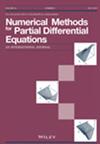Numerical solution of the boundary value problem of elliptic equation by Levi function scheme
IF 1.7
3区 数学
Q1 MATHEMATICS, APPLIED
引用次数: 0
Abstract
For boundary value problem of an elliptic equation with variable coefficients describing the physical field distribution in inhomogeneous media, the parametrix can represent the solution in terms of volume and surface potentials, with the drawback that the volume potential involving in the solution expression requires heavy computational costs as well as the solvability of the integral equations with respect to the density pair. We introduce an modified integral expression for the solution to an elliptic equation in divergence form under the parametrix framework. The well‐posedness of the linear integral system with respect to the density functions to be determined is rigorously proved. Based on the singularity decomposition for the parametrix, we propose two schemes to deal with the volume integrals so that the density functions can be solved efficiently. One method is an adaptive discretization scheme for computing the integrals with continuous integrands, leading to the uniform accuracy of the integrals in the whole domain, and consequently the efficient computations for the density functions. The other method is the dual reciprocity method which is a meshless approach converting the volume integrals into boundary integrals equivalently by expressing the volume density as the combination of the radial basis functions determined by the interior grids. The proposed schemes are justified numerically to be of satisfactory computation costs. Numerical examples in 2‐dimensional and 3‐dimensional cases are presented to show the validity of the proposed schemes.用列维函数方案数值求解椭圆方程的边界值问题
对于描述非均质介质中物理场分布的具有可变系数的椭圆方程的边界值问题,参数矩阵可以用体积势和面势来表示解,但缺点是解表达式中涉及的体积势需要高昂的计算成本,以及关于密度对的积分方程的可解性。我们引入了参数矩阵框架下发散形式的椭圆方程解的修正积分表达式。严格证明了线性积分系统关于待定密度函数的良好求解性。基于参数矩阵的奇异性分解,我们提出了两种处理体积积分的方案,以便高效求解密度函数。一种方法是自适应离散化方案,用于计算连续积分的积分,从而使整个域的积分精度一致,进而高效计算密度函数。另一种方法是双互易法,它是一种无网格方法,通过将体积密度表示为由内部网格确定的径向基函数的组合,将体积积分等效转换为边界积分。通过数值计算证明,所提出的方案具有令人满意的计算成本。我们还给出了二维和三维的数值示例,以说明所提方案的有效性。
本文章由计算机程序翻译,如有差异,请以英文原文为准。
求助全文
约1分钟内获得全文
求助全文
来源期刊
CiteScore
7.20
自引率
2.60%
发文量
81
审稿时长
9 months
期刊介绍:
An international journal that aims to cover research into the development and analysis of new methods for the numerical solution of partial differential equations, it is intended that it be readily readable by and directed to a broad spectrum of researchers into numerical methods for partial differential equations throughout science and engineering. The numerical methods and techniques themselves are emphasized rather than the specific applications. The Journal seeks to be interdisciplinary, while retaining the common thread of applied numerical analysis.

 求助内容:
求助内容: 应助结果提醒方式:
应助结果提醒方式:


